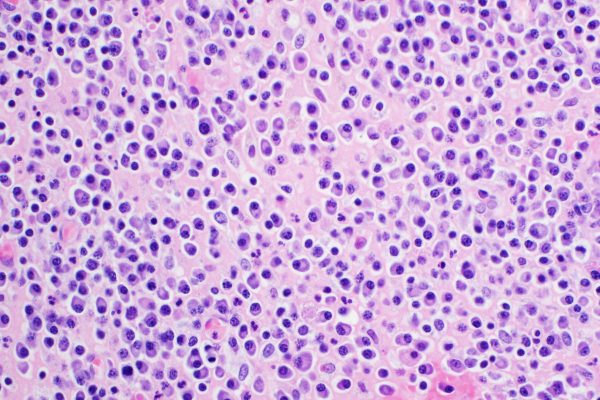
Updated efficacy and safety analyses from the phase III MAIA study after a median follow-up over five years continue to support frontline use of the addition of daratumumab to lenalidomide and dexamethasone in patients with transplant-ineligible newly diagnosed myeloma.
Daratumumab, a monoclonal antibody targeting CD38, is approved as monotherapy for patients with relapsed or refractory multiple myeloma (RRMM) and in combination regimens for patients with RRMM or newly diagnosed multiple myeloma (NDMM). The phase III MAIA study showed that the addition of daratumumab to lenalidomide and dexamethasone (D-Rd) significantly improved progression-free survival (PFS) and the rate of minimal residual disease (MRD) negativity in transplant-ineligible NDMM patients, as compared to Rd alone.1 Long-term follow-up (56.2 months) demonstrated that that D-Rd improved overall survival (OS) compared to Rd alone.2 Sustained MRD negativity was associated with improved PFS.3 The updated efficacy and safety results from the MAIA trial with a median follow-up of 64.5 months, marking the final and longest follow-up with a complete dataset, including a subgroup analysis based on patient age, were recently published in Leukemia.4
MAIA is a multicentre, randomised, open-label, phase III trial involving transplant-ineligible patients with NDMM. Eligible patients had documented NDMM, an Eastern Cooperative Oncology Group performance status of zero to two, and were ineligible for high-dose chemotherapy with autologous stem cell transplant due to age (>65 years) or comorbidities. Patients were randomly assigned to D-Rd or Rd, stratified by disease stage, region and age. All patients received oral lenalidomide and dexamethasone in 28-day cycles until disease progression or unacceptable toxicity. Patients in the D-Rd group also received intravenous daratumumab. The primary endpoint was PFS, defined as the time from randomisation to disease progression or death. Secondary endpoints included complete response (CR) rate, stringent CR rate, overall response rate (ORR), MRD-negativity, PFS on next line of therapy, and OS.
A total of 737 patients were randomised to D-Rd (median treatment duration of 47.5 months) or Rd (median treatment duration 22.6 months). Treatment discontinuation was lower in the D-Rd group (64.0%) compared to the Rd group (85.2%), with disease progression and adverse events being the most common causes. The median PFS with D-Rd was 61.9 months vs 34.4 months with Rd (HR[95%CI]: 0.55[0.45-0.67], p< 0.0001), with estimated 60-month PFS rates of 52.1% and 29.6%, respectively. Median OS was not reached in the D-Rd arm vs 65.5 months in the Rd arm (HR[95%CI]:0.66[0.53–0.83], p= 0.0003), with estimated 60-month OS rates of 66.6% and 53.6%, respectively. PFS and OS benefits with D-Rd vs Rd was consistent across all pre-specified age groups (<70, >70 to <75, >75, and >80 years). D-Rd resulted in higher rates of CR or better (>CR: 51.1% vs 30.1%), MRD negativity (32.1% vs 11.1%, and sustained MRD negativity (>18 months: 16.8% vs 3.3%) compared to Rd (all p< 0.0001). No new safety concerns were observed with longer follow-up. Grade 3/4 treatment-emergent adverse events (TEAEs) were more frequent in the D-Rd arm (95.9%) compared to the Rd arm (88.8%). The most common TEAEs with D-Rd versus Rd included neutropenia (54.1% vs 37.0%) and anaemia (17.0% vs 21.6%). Serious TEAEs occurred in 78.8% (D-Rd) vs 71.0% (Rd) of patients, with pneumonia as the most common serious TEAE. Overall rate of study treatment discontinuation due to TEAEs was lower with D-Rd compared to Rd with 14.6% and 23.8%, respectively. Similar observations were seen in the subgroup analyses of safety in patients aged >75 and >80 years.
The updated efficacy and safety analysis from the MAIA trial, with a median follow-up over 5 years, further support the frontline use of D-Rd in transplant-ineligible patients with NDMM. D-Rd showed clinically significant efficacy benefits across all age groups, with no new safety concerns identified.These results, representing the longest follow-up with a complete dataset, reinforce the use of daratumumab in patients with multiple myeloma.
2. Facon T, Kumar SK, Plesner T, et al. Daratumumab, lenalidomide, and dexamethasone versus lenalidomide and dexamethasone alone in newly diagnosed multiple myeloma (MAIA): overall survival results from a randomised, open-label, phase 3 trial. Lancet Oncol. 2021;22(11):82-96.